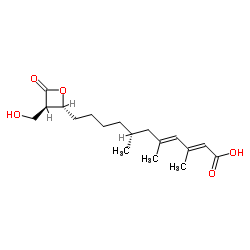Characterization of peroxisomal 3-hydroxy-3-methylglutaryl coenzyme A reductase in UT2 cells: sterol biosynthesis, phosphorylation, degradation, and statin inhibition.
N Aboushadi, J E Shackelford, N Jessani, A Gentile, S K Krisans
文献索引:Biochemistry 39(1) , 237-47, (2000)
全文:HTML全文
摘要
We have previously identified a CHO cell line (UT2 cells) that expresses only one 3-hydroxy-3-methylglutaryl coenzyme A (HMG-CoA) reductase protein which is localized exclusively in peroxisomes [Engfelt, H.W., Shackelford, J.E., Aboushadi, N., Jessani, N., Masuda, K., Paton, V.G., Keller, G.A., and Krisans, S.K. (1997) J. Biol. Chem. 272, 24579-24587]. In this study, we utilized the UT2 cells to determine the properties of the peroxisomal reductase independent of the endoplasmic reticulum (ER) HMG-CoA reductase. We demonstrated major differences between the two proteins. The peroxisomal reductase is not the rate-limiting enzyme for cholesterol biosynthesis in UT2 cells. The peroxisomal reductase protein is not phosphorylated, and its activity is not altered in the presence of inhibitors of cellular phosphatases. Its rate of degradation is not accelerated in response to mevalonate. Finally, the degradation process is not blocked by N-acetyl-Leu-Leu-norleucinal (ALLN). Furthermore, the peroxisomal HMG-CoA reductase is significantly more resistant to inhibition by statins. Taken together, the data support the conclusion that the peroxisomal reductase is functionally and structurally different from the ER HMG-CoA reductase.
相关化合物
| 结构式 | 名称/CAS号 | 分子式 | 全部文献 |
|---|---|---|---|
 |
Hymeglusin
CAS:29066-42-0 |
C18H28O5 |
|
Binding site for fungal beta-lactone hymeglusin on cytosolic...
2004-02-27 [Biochim. Biophys. Acta 1636(1) , 22-8, (2004)] |
|
Biosynthesis of antibiotic 1233A (F-244) and preparation of ...
1992-04-01 [J. Antibiot. 45(4) , 563-7, (1992)] |
|
Inhibition of 3-hydroxy-3-methylglutaryl coenzyme A synthase...
1990-06-15 [Biochem. Biophys. Res. Commun. 169(2) , 610-6, (1990)] |
|
Isopentenoid synthesis in eukaryotic cells. An initiating ro...
1993-04-01 [Arch. Biochem. Biophys. 302(1) , 265-71, (1993)] |
|
Inhibition of hepatic cholesterol biosynthesis by a 3-hydrox...
1993-01-01 [Life Sci. 52(19) , 1595-600, (1993)] |